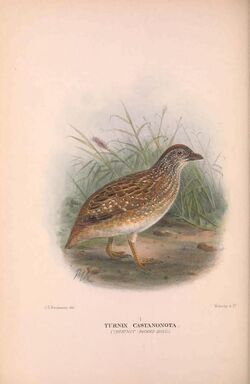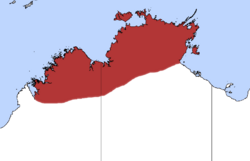Biology:Chestnut-backed buttonquail
| Chestnut-backed buttonquail | |
|---|---|

| |
| Scientific classification | |
| Domain: | Eukaryota |
| Kingdom: | Animalia |
| Phylum: | Chordata |
| Class: | Aves |
| Order: | Charadriiformes |
| Family: | Turnicidae |
| Genus: | Turnix |
| Species: | T. castanotus
|
| Binomial name | |
| Turnix castanotus (Gould, 1840)
| |

| |
| Distribution of the chestnut-backed buttonquail | |
| Synonyms[2] | |
|
Hemipodius castanotus Gould | |
The chestnut-backed buttonquail (Turnix castanotus) is a species of bird in the family Turnicidae. It is endemic to Australia .
Taxonomy
John Gould described the species in 1840, from a specimen collected by Benjamin Bynoe, ship's surgeon of HMS Beagle, from northwestern Australia, as Hemipodius castanotus.[3] English zoologist George Gray placed it in the genus Turnix in 1870.[4] William Robert Ogilvie-Grant corrected the name to Turnix castanonota in 1889.[5] Three subspecies were described by Gregory Mathews,[2] but all are now considered as invalid and merely individual variants.[6]
Etymology
"Chestnut-backed buttonquail" has been designated the official name by the International Ornithologists' Union (IOC).[7] The species name is derived from the Ancient Greek words kastanon "chestnut" and noton "back".[8] Gould called it "chestnut-backed hemipode" in 1848, noting the colonists called it "thick-billed quail". The buttonquail species were generally known as "quail" (hence "chestnut-backed quail" ) until the RAOU promoted the current usage of "buttonquail" in 1978, which was then universally adopted.[8]
Distribution and habitat
Native to northern Australia, the species ranges from the Dampier Peninsula in Western Australia across to Westmoreland Station in the Gulf Country of northwestern Queensland, with possible records from Gregory Downs and Augustus Downs further east. It is also native to Melville Island and Groote Eylandt. It was common around Borroloola and McArthur River, but not currently. Its existence in Queensland was only confirmed in 2020.[9]
Its natural habitats are low grasslands and Eucalyptus forests and woodland, favouring quartzite-sandstone ridges, plateaus and escarpments, mostly (but not always) in areas that receive over 800 mm (31 in) summer rainfall.[6]
Behaviour
The usual sex roles are reversed in the buttonquail genus (Turnix), as the larger and more brightly-coloured female mates with multiple male partners and leaves them to incubate the eggs.[10] The female lays a clutch of 1–5 (usually 4) pyriform eggs, which are glossy-white with sparse small dark blotches.[11]
References
- ↑ BirdLife International (2016). "Turnix castanotus". IUCN Red List of Threatened Species 2016: e.T22680560A92866466. doi:10.2305/IUCN.UK.2016-3.RLTS.T22680560A92866466.en. https://www.iucnredlist.org/species/22680560/92866466. Retrieved 11 November 2021.
- ↑ 2.0 2.1 Australian Biological Resources Study (1 May 2014). "Species Turnix (Austroturnix) castanotus (Gould, 1840)". Australian Faunal Directory. Canberra, Australian Capital Territory: Department of the Environment, Water, Heritage and the Arts, Australian Government. https://biodiversity.org.au/afd/taxa/57c22ce8-63af-4da8-8a7a-aee6ed433375.
- ↑ Gould, John (1840). ". Letter to Chairman of the Scientific Committee, Zoological Society of London, read before meeting of the Society of Oct. 8, 1839". Proceedings of the Zoological Society of London 7: 139–145. https://www.biodiversitylibrary.org/page/30571382.
- ↑ Gray, G.R. (1870). Hand-list of genera and species of birds, distinguishing those contained in the British Museum. London: British Museum. p. 270. https://www.biodiversitylibrary.org/page/8388909.
- ↑ Ogilvie-Grant, William Robert (1889). "On the Genus Turnix". Ibis 31 (4): 446–475 [453]. doi:10.1111/j.1474-919X.1889.tb06396.x. https://www.biodiversitylibrary.org/page/16280833.
- ↑ 6.0 6.1 McGowan, Phil; Madge, Steve (2010). Pheasants, Partridges & Grouse: Including buttonquails, sandgrouse and allies. London, United Kingdom: Bloomsbury Publishing. pp. 430–431. ISBN 9781408135655. https://books.google.com/books?id=WffUBAAAQBAJ&pg=PA430.
- ↑ Gill, Frank; Donsker, David, eds (2021). "Buttonquail, thick-knees, sheathbills, plovers, oystercatchers, stilts, painted-snipes, jacanas, Plains-wanderer, seedsnipes". World Bird List Version 12.1. International Ornithologists' Union. https://www.worldbirdnames.org/new/bow/buttonquail/.
- ↑ 8.0 8.1 Gray, Jeannie; Fraser, Ian (2019). Australian Bird Names: Origins and Meanings. Collingwood, Victoria: Csiro Publishing. pp. 50–51. ISBN 978-1-486-31164-4. https://books.google.com/books?id=aTytDwAAQBAJ.
- ↑ Webster, Patrick T.D.; Stoetzel, Henry J. (2021). "First confirmed record of Chestnut-backed Button-quail Turnix castanotus in Queensland". Australian Field Ornithology 38: 145–150. doi:10.20938/afo38145150.
- ↑ Wade Peter, ed (1977). Every Australian Bird Illustrated. Rigby. pp. 78–79. ISBN 0-7270-0009-8.
- ↑ Webster, Patrick; Jackett, Nigel; Mason, Ian; Rush, Emily; Leseberg, Nicholas; Watson, James (2022). "Nests and eggs of the Chestnut-backed Button-quail Turnix castanotus: Two new nests and a review of previous descriptions". Australian Field Ornithology 39: 12–18. doi:10.20938/afo39012018.
Wikidata ☰ Q1270026 entry
 |


